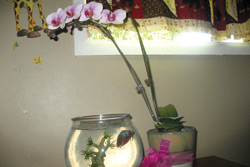Like everything else in life, gardens can be trendy, and when it comes to that, I’m as weak as the next person. Sedums are this year’s garden darlings, toppling over one another in container-pot arrangements everywhere I go. Some of these artful pots sell for $100 or more. I almost bought a particularly amazing potted arrangement recently, but my 15-year-old son, Micah, took me by the hand and dragged me back to our car. (I’ve rescued him from a few expensive pairs of soccer shoes, so we’re even.)

Sedum, or stonecrop, belongs to the Crassulaceae family—the succulents, whose leaves and stems store water. They’re perfect for that sun-parched, water-thirsty spot in your yard, or—my favorite—a rock garden. Tuck these easygoing plants into small spaces between rocks with just a tiny bit of soil, and watch them trail and thrive. In my garden, they fit perfectly into that problem spot that every garden has, where no matter what you do, the soil remains dry and over-baked. And if you’re into Xeriscaping—an approach using drought-resistant plants—sedums must be on your list. They get a green star for water conservation.
What’s more, the species’ 400 varieties come in all sizes and colors. They’re considered a foliage plant, meaning their garden value lies in the shape and color of their sometimes plump and round, sometimes rosette, sometimes oval leaves: Pink, rose, salmon, burgundy and frosted are just a few common colors. But don’t discount the flowers. ‘Dragon’s Blood’, a popular cultivar, has brilliant red flowers and can be used for edgings, where it will spill out into walkways, creating a beautiful display. ‘Gold Moss’ sedum has dazzling, spring-blooming yellow flowers. Both short, these sedums are most frequently used as ground covers or edgings, in rock gardens and container pots, and to fill bare spots. Some cultivars, such as ‘Ogon’, can even tolerate foot traffic.
And though they’ll spread, sedums aren’t invasive. The word sedum comes from the Latin verb “to sit,” and that’s what these succulents do: more or less stay put, even on rooftops. One I simply must mention is wild stonecrop (Sedum ternatum), a shade plant that loves rich, deciduous forest soil. Mine grow under the rhododendrons, but they also do well in partial shade.
The tall sedums are the ones most of us are familiar with. Ten to 24 inches in height, you’ll often see them along highways, and they’re very common in most gardens, blooming in late fall. The most popular is ‘Autumn Joy’, a pinkish-red, broccoli-head bloom that can sometimes flop and get too leggy. If that happens, you may be watering and fertilizing it too much. Remember, sedums are designed for the tough spots in our gardens: They don’t need to be babied. Let your container sedums dry out completely between waterings.
Another no-no for sedums: Avoid planting them in clay pots, which can lead to root rot. Sedums prefer a well-drained, loamy soil, especially for container plantings. For the most part, however, these little garden delights are adaptable, handling neutral, alkaline or slightly acidic soils. Compared to my high-maintenance sweet peas (whose days just may be numbered in my garden), sedums are a pure joy, providing great rewards for little work.
Additionally, sedums draw bees and butterflies (so if you have children, plant them where bare feet won’t step on a bee), while apparently repelling deer and rabbits. What’s not to love about these hardy little plants? They have texture, color and shape; need little water; and add drama to any size garden. And thanks to their shallow but tenacious roots, they’re also used in living roofs (which also deliver reduced storm-water runoff, lower heating and cooling bills, and a more aesthetically pleasing look). If you’re flat out of garden space, this might seem appealing, though you’ll need to consult an engineer and go through the permitting process to make sure your roof can handle the extra weight.
My favorite thing to do with sedums, however, is plant them in wide-top containers along with hens-and-chicks, another plant that’s fashionable this year—but that’s a story for another column.
[Cinthia Milner lives in Leicester.]



Before you comment
The comments section is here to provide a platform for civil dialogue on the issues we face together as a local community. Xpress is committed to offering this platform for all voices, but when the tone of the discussion gets nasty or strays off topic, we believe many people choose not to participate. Xpress editors are determined to moderate comments to ensure a constructive interchange is maintained. All comments judged not to be in keeping with the spirit of civil discourse will be removed and repeat violators will be banned. See here for our terms of service. Thank you for being part of this effort to promote respectful discussion.